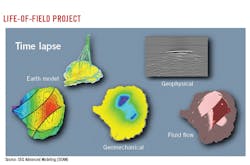William L. Abriel
Orinda Geophysical
Orinda, Calif.
The emerging science and application of artificial intelligence (AI) to applied geophysics can be significant and a positive step change in advancing the science.
As current past president of the Society of Exploration Geophysicists (SEG), I’d like to comment on SEG’s major initiatives regarding artificial intelligence (AI). The application of AI is very promising for increasing efficiency and quality in applied subsurface geophysics.
Every year, SEG holds numerous AI workshops and forums, professional development courses, and special AI publications. But the potential for AI as a game-changing technology has further motivated the SEG to plan two new long-term projects.
One is the formation of a cooperative global geophysical research project. The other is a joint integrated industry conference addressing AI applications in geology, geophysics, and engineering.
Petroleum geophysics has a long history of working “Big Data,” but this expertise is expanding rapidly with the application of intelligent operators, feature engineering, machine learning, and cloud computing.
In subsurface analysis and management, AI potentially could increase efficiency in processing, analysis, and the integration of geophysics with geology and engineering.
Most geophysical data (mainly seismic) is massively underinterpreted. Only a sparse portion of the data is fully analyzed for geological parameters like topography, structural history, fault systems, stratigraphic sequence, facies, lithology, porosity, fluid, pressure, and stress.
AI could augment interpreters’ capabilities to provide these in full multidimensional volumes. As an additional example of possible AI application, work flows can be streamlined using “intelligent operators” to mimic and aid the human decision processes when making judgements in data processing.
Some suggest AI can help integrate different data streams from reservoir and time lapse seismic, closing the loop in 4D seismic reservoir monitoring.
SEAM
To advance the science and application of AI to petroleum geophysics, SEG is building an industry cooperative through its research corporation SEG Advanced Modeling (SEAM), which has operated several projects over 10 years (OGJ, Oct. 3, 2016, p. 22).
An example of SEAM’s cooperative research is an ongoing project where multiple companies supported the design and execution of a digital simulation in a producing field. All relevant components of the field are simulated including geology, reservoir fluid flow, simulated geomechanics, and synthetic time lapse geophysics (Figure).
SEAM enables geophysicists, geologists, and engineers to test theories and transfer what they learn to real subsurface environments, providing a complete package suitable for benchmarking reservoir management workflows with realistic and fully synthetic data. The next project that SEAM is launching in 2019 directly addresses AI.
One aim of the next research project is to enable fundamental technologies such as standard data formats and data compression. The project’s goals include:
• Defining, obtaining, and distributing fit-for-purpose benchmark data to test applications.
• Collecting and evaluating results for accuracy and efficiency, providing feedback.
• Managing a global communications network using AI for petroleum geophysics.
A second major initiative is the launch of an annual integrated industry conference on AI coordinated by the SEG, the American Association of Petroleum Geologists (AAPG), and the Society of Petroleum Engineers (SPE). The aim of the annual conference will be to provide a global forum where developers, users, and investors can exchange knowledge of AI across the entire petroleum management value chain.
SEG members are dedicated to supporting and assisting the best and highest purpose of subsurface geophysics.
The author
William L. (Bill) Abriel ([email protected]) is the past president of the Society of Exploration Geophysicists (SEG). He founded Orinda Geophysical in Orinda, Calif., after having worked 38 years at Chevron Corp. applying new technology to international projects. His work included integrated use of geology, geophysics, and engineering for production management, and Chevron’s commercial development and deployment of subsalt seismic processing and interpretation in the Gulf Mexico. Abriel was principle geophysicist for Chevron in many geological areas. He managed projects in the Gulf of Mexico, Appalachian region, US rift basins, West Texas, offshore California, Venezuela, Brazil, North Sea, Black Sea, Caspian Sea, Russia, Kazakhstan, Turkey, China, offshore Siberia, and Australia. He earned a BS in geosciences (1975) and an MS in geophysics (1978) from Pennsylvannia State University. Abriel is a founder and twice served as chair of non-profit research company, SEG Advanced Modeling (SEAM) Corp. He was awarded SEG life membership in 2007 and served as president in 2016-17.




